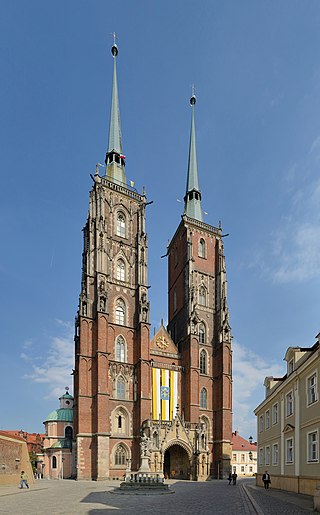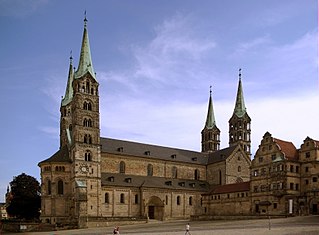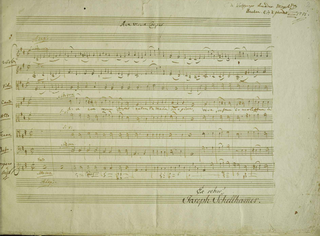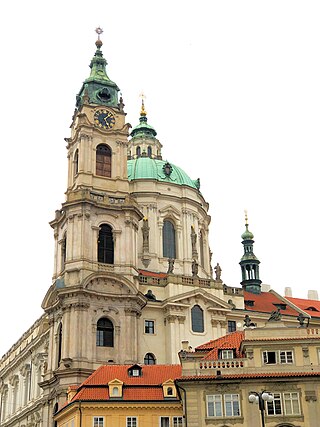
St. Stephen's Cathedral is a Roman Catholic church in Vienna, Austria, and the mother church of the Archdiocese of Vienna. It is the seat of the Archbishop of Vienna, Christoph Schönborn.
Ave verum corpus is a short Eucharistic chant that has been set to music by many composers. It dates to the 13th century, first recorded in a central Italian Franciscan manuscript. A Reichenau manuscript of the 14th century attributes it to Pope Innocent

The St. Thomas Church is a Lutheran church in Leipzig, Germany, located at the western part of the inner city ring road in Leipzig's central district. Martin Luther preached in the church in 1539. It is associated with several well-known composers, especially Johann Sebastian Bach, who was its Thomaskantor from 1723 until his death in 1750. The church holds his remains.

The St. John the Baptist Archcathedral is the seat of the Archdiocese of Wrocław and a landmark of the city of Wrocław in Poland. The cathedral, located in the Cathedral Island, is a Gothic church with Neo-Gothic additions. The current standing cathedral is the fourth church to have been built on the site.

Bamberg Cathedral is a church in Bamberg, Germany, completed in the 13th century. The cathedral is under the administration of the Archdiocese of Bamberg and is the seat of its archbishop. Since 1993, the cathedral has been part of the UNESCO World Heritage Site "Town of Bamberg".

Saint Michael's Church is one of the oldest churches in Vienna, Austria, and also one of its few remaining Romanesque buildings. Dedicated to the Archangel Michael, St. Michael's Church is located at Michaelerplatz across from St. Michael's Gate at the Hofburg Palace. St. Michael's used to be the parish church of the Imperial Court, when it was called Zum heiligen Michael.

St. Sebaldus Church is a medieval church in Nuremberg, Germany. Along with Frauenkirche and St. Lorenz, it is one of the most important churches of the city, and also one of the oldest. It is located at the Albrecht-Dürer-Platz, in front of the old city hall. It takes its name from Sebaldus, an 8th-century hermit and missionary and patron saint of Nuremberg. It has been a Lutheran parish church since the Reformation.

Harald Feller is a German organist, choral conductor and composer teaching at the Hochschule für Musik und Theater München. He was awarded the 1983 Grand Prix du Disque Liszt.

Ave verum corpus, , is a motet in D major composed by Wolfgang Amadeus Mozart in 1791. It is a setting of the Latin hymn of the same name. Mozart wrote it for Anton Stoll, a friend who was the church musician of St. Stephan in Baden bei Wien. The motet was composed for the feast of Corpus Christi; the autograph is dated 17 June 1791. It is scored for SATB choir, string instruments and organ.

St. Martin is the name of a Catholic parish and church in Idstein, Rheingau-Taunus-Kreis, Germany. The official name of the church is Katholische Pfarrkirche St. Martin. The name of the parish became St. Martin Idsteiner Land on 1 January 2017, when it was merged with five other parishes. The parish is part of the Diocese of Limburg.

The church of St. Gumbertus, named for Saint Gondelbert, is one of the central city churches of Ansbach, Bavaria, together with the neighboring St. Johannis. Located in the Altstadt of Ansbach, St. Gumbertus, now a Lutheran church, was originally the church of a monastery that was founded by St. Gumbert around 750. Today it serves as a venue for concerts of the music festival Bachwoche Ansbach. The church contains the oldest structures in Ansbach and is considered Ansbach's city symbol.

The Waldsassen Basilica, Mariä Himmelfahrt und St. Johannes Evangelist is the parish church in Waldsassen, Bavaria. It was built in its present form from 1685 to 1704 as part of the Waldsassen Abbey. With the secularization in 1803, the Cistercian abbey church became the Catholic parish church. In 1969, Pope Paul VI made it a papal basilica minor. The basilica is known for its display of jewelled skeletons.

The Church of Saint Nicholas is a Baroque church in the Lesser Town of Prague. It was built between 1704 and 1755 on the site where formerly a Gothic church from the 13th century stood, which was also dedicated to Saint Nicholas. It has been described as the greatest example of Prague Baroque.

St. Michael's Church in Jircháře, Prague - New Town near the National Theatre, specifically the New Town street, which is called v Jirchářích. It is the seat of Czech, Slovak and English congregation of the Evangelical Church of the Augsburg Confession in the Czech Republic. Its architectural style is not uniform due to alterations in different periods and styles. It is protected as a cultural monument of the Czech Republic.

Liebfrauenkapelle is a chapel in Rapperswil, Canton of St. Gallen, Switzerland, which dates back to the ossuary that was built by the House of Rapperswil around 1253 AD.

The composition of Mozart's unfinished Requiem, K. 626, his last work, is surrounded by the following events.

Mozart: Grosse Messe c-moll KV 427 is an 86-minute live video album of Wolfgang Amadeus Mozart's Christian vocal works Great Mass in C minor, Ave verum corpus and Exsultate, jubilate, performed by Arleen Auger, Cornelius Hauptmann, Frank Lopardo, Frederica von Stade, the Bavarian Radio Symphony Chorus and the Bavarian Radio Symphony Orchestra under the direction of Leonard Bernstein. Deutsche Grammophon issued it on VHS video cassette, Laserdisc and DVD, and also released audio cassette and CD versions of its soundtrack.

St. Michael is a Lutheran church and parish in Fürth, Bavaria, Germany, also called Stadtpfarrkirche St. Michael, indicating that it is the town's most prominent church. Building began in the 12th century. After Fürth became Protestant the building was remodelled in Baroque style, including balconies. An organ and stained-glass windows were installed in the 20th century.

The parish church of Kainach bei Voitsberg, often called Kainach parish church, is the Catholic parish church of the parish of Kainach, located in the municipality of Kainach bei Voitsberg in western Styria, Austria. The church, dedicated to St. George, belongs to the pastoral area of Voitsberg in the diocese of Graz-Seckau.

Salem Minster is the Roman Catholic parish church of the community of Salem, Baden-Württemberg and was the abbey church of the former imperial abbey of Salem. It was built in Gothic architecture from around 1285 to 1420 as a three-aisled columned basilica and is one of the most important High Gothic Cistercian buildings in the German-speaking world. The exterior of the church largely corresponds to the original design, while alterations to the interior have had a lasting effect on the sense of space within. The inventory includes furnishings from the late Gothic, Baroque, Rococo and Classicist periods. It is the third largest Gothic church in Baden-Württemberg after Ulm Minster and Freiburg Minster.





















